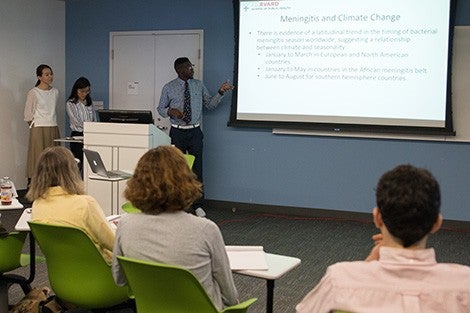May 15, 2018 – In Burkina Faso, which has some of the highest meningitis rates in the world, it appears that as the temperature climbs, so does the death rate from the disease—with nearly half of those deaths occurring in children age 5 and under.
The relationship between heat and meningitis-related mortality in Burkina Faso was one of five topics on the agenda at a May 9, 2018 event at Harvard T.H. Chan School of Public Health. All the presentations were given by students in a course taught by Rainer Sauerborn, visiting professor in the Department of Environmental Health. The course gives students hands-on skills to use existing data from Africa and Asia to analyze potential links between climate change and mortality.

Over the past 40 years in West Africa, the temperature rose between 0.5 and 0.8 degrees Celsius, and it’s predicted to jump another 0.5 to 1.0 degree Celsius by the year 2100, said students Jayson Toweh, Jing Li, and Chinghou You. From 1940-2002, there have been periodic meningitis epidemics in the so-called “meningitis belt” in sub-Saharan Africa, where Burkina Faso is located. Just before 2000 there was a huge epidemic—the biggest ever recorded in the region, with more than 40,000 cases of meningitis—raising concerns about the possible impact of climate change.
Using data from 2001-2010, the students found “profound” associations between high temperature and meningitis deaths.
Other student presentations focused on the effect of weather variability on malaria mortality in Nouna, Burkina Faso; the association between malnutrition-related deaths and rainfall; temperature variability and cardio- and cerebrovascular diseases; and the effect of rainfall on diarrhea-related deaths.
photos: Craig LaPlante
